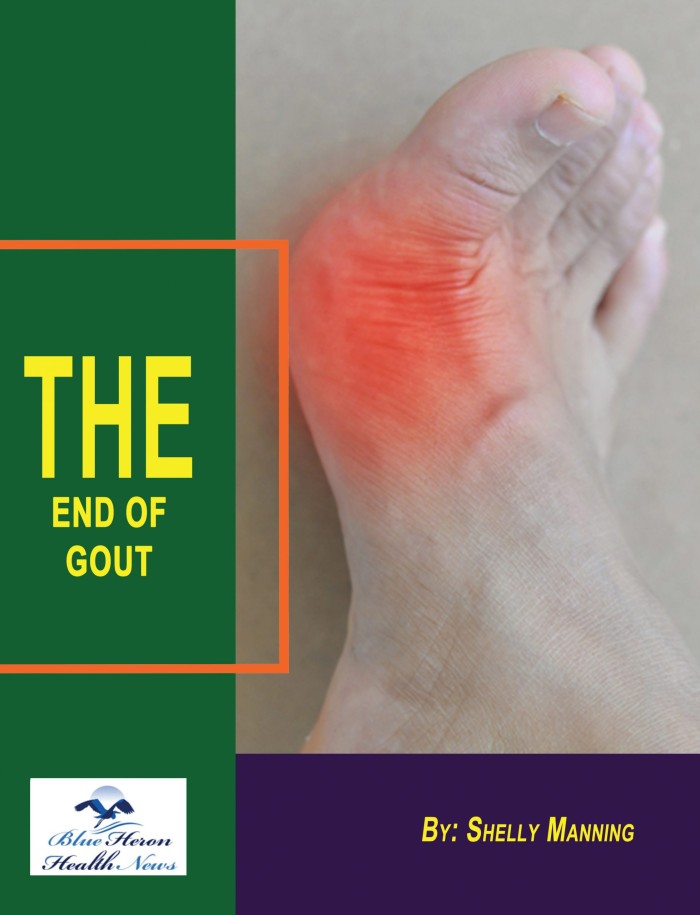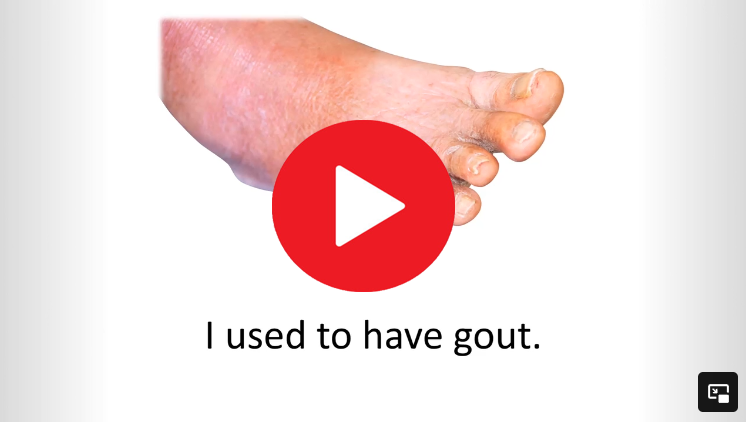This eBook from Blue Heron Health NewsBack in the spring of 2008, Christian Goodman put together a group of like-minded people – natural researchers who want to help humanity gain optimum health with the help of cures that nature has provided. He gathered people who already know much about natural medicine and setup blueheronhealthnews.com. Today, Blue Heron Health News provides a variety of remedies for different kinds of illnesses. All of their remedies are natural and safe, so they can be used by anyone regardless of their health condition. Countless articles and eBooks are available on their website from Christian himself and other natural health enthusiasts, such as Julissa Clay , Shelly Manning , Jodi Knapp and Scott Davis. |
Gout and Blockchain Technology in Healthcare
Gout and blockchain technology in healthcare may seem unrelated at first glance, but there are innovative ways in which blockchain can potentially improve the management and treatment of gout, along with other medical conditions. Let’s break down each concept and explore how blockchain could be applied in the context of gout management and healthcare in general.
1. Understanding Gout
Gout is a type of arthritis caused by the accumulation of uric acid crystals in the joints, leading to sudden and severe pain, redness, and swelling. It commonly affects the big toe but can involve other joints as well. The condition is often triggered by factors such as:
High purine levels (from foods like red meat, shellfish, etc.)
Obesity
Excessive alcohol consumption
Medications that increase uric acid levels
Kidney dysfunction (which impairs uric acid excretion)
Gout management involves:
Medications to reduce pain and inflammation, like NSAIDs (non-steroidal anti-inflammatory drugs) and colchicine.
Uric acid-lowering drugs, such as allopurinol or febuxostat, to prevent flare-ups.
Lifestyle changes, including dietary adjustments and weight management.
2. Blockchain Technology in Healthcare
Blockchain is a distributed ledger technology that ensures data is securely stored, transparent, and immutable. It is often associated with cryptocurrencies, but its potential in healthcare goes far beyond that. Blockchain could bring significant improvements in various aspects of healthcare, such as:
Data security and privacy: Storing patient information in a blockchain can prevent unauthorized access and ensure privacy.
Interoperability: Blockchain can facilitate the secure sharing of patient data across different healthcare providers and institutions.
Supply chain management: Blockchain can improve transparency and traceability in drug supply chains.
Smart contracts: These are self-executing contracts with the terms directly written into code, enabling automation and reducing the need for intermediaries.
3. How Blockchain Can Benefit Gout Management and Healthcare
Here are a few potential ways blockchain technology could enhance gout treatment and healthcare delivery:
a. Improved Patient Data Management
Blockchain could provide a secure, decentralized platform for storing patient medical records. For patients with gout, this could mean:
Tracking medication history: Blockchain could ensure that patients’ medication history is easily accessible, helping doctors adjust treatment plans and avoid prescribing conflicting medications.
Personalized treatment: By securely storing genetic data, lifestyle habits, and past treatments on a blockchain, healthcare providers could tailor gout treatments based on the patient’s individual needs and risk factors.
b. Improved Medication Adherence
Medication adherence is a critical challenge in managing gout. Blockchain-based solutions could help improve adherence in the following ways:
Smart contracts for reminders: Blockchain could automate reminder systems for taking gout medications, ensuring that patients stick to their prescribed regimens.
Proof of adherence: Patients could receive tokens or incentives for adhering to their medication schedule, and healthcare providers could use blockchain to track this.
c. Transparency in Gout Drug Supply Chains
The supply chain for medications used to treat gout (like allopurinol or colchicine) could benefit from blockchain. A transparent, immutable ledger could:
Prevent counterfeit drugs: Blockchain could track the production and distribution of medications, ensuring that patients receive genuine drugs.
Track drug efficacy and side effects: By logging batch numbers, side effects, and patient experiences on the blockchain, healthcare providers could track and analyze the effectiveness of different drugs in treating gout.
d. Research and Clinical Trials
Blockchain can facilitate data sharing in clinical research and trials related to gout treatments. It can:
Ensure data integrity: Researchers can use blockchain to securely store trial data, making it immutable and verifiable.
Improve collaboration: Blockchain allows multiple parties (researchers, healthcare providers, patients) to collaborate on research while ensuring that each party has access to accurate and up-to-date information.
e. Decentralized Healthcare Records
Patients with gout could have ownership and control over their own medical records, which could be securely stored on a blockchain. This would give them the ability to:
Share data with specialists: Blockchain could allow gout patients to share their records seamlessly and securely with specialists (e.g., nephrologists, rheumatologists) for a more holistic approach to care.
Track long-term health: Over time, patients could build a comprehensive health record on the blockchain, tracking uric acid levels, medications, flare-ups, and lifestyle changes.
f. Patient-Centric Care and Autonomy
Blockchain can empower patients with more autonomy over their treatment. For instance:
Access to treatment options: Patients could use blockchain to access a database of treatment options, clinical guidelines, and research findings related to gout.
Transparent pricing: By utilizing blockchain, patients could access transparent information about the cost of medications and treatments, helping them make more informed decisions about their care.
g. Healthcare Interoperability
Blockchain can overcome interoperability issues between healthcare systems. For gout patients, this means:
Seamless coordination: Healthcare providers across different regions or specialties could access up-to-date information about the patient’s condition, treatment history, and lab results, leading to better-coordinated care.
Global access: Blockchain could facilitate global health data access, making it easier for gout patients to receive treatment regardless of their location.
4. Challenges of Implementing Blockchain in Gout Management
While blockchain has great potential, there are several challenges to overcome before its widespread implementation in gout management:
Data privacy concerns: Although blockchain is secure, ensuring that personal health information is kept confidential and compliant with regulations like HIPAA (in the U.S.) or GDPR (in Europe) is crucial.
Integration with existing systems: Many healthcare institutions still rely on legacy systems. Integrating blockchain into these systems can be complex and costly.
Technical expertise: Implementing blockchain technology requires specialized knowledge, which may be lacking in some healthcare settings.
Regulatory hurdles: Healthcare is highly regulated, and blockchain-based solutions will need to comply with existing laws and guidelines, which can vary across regions and countries.
5. Future Outlook for Blockchain in Gout Treatment and Healthcare
The integration of blockchain in gout treatment and healthcare, in general, is still in its early stages but shows promise. As the technology matures, we could see more pilot programs and partnerships between blockchain developers and healthcare providers to:
Improve medication adherence and patient outcomes.
Enhance data sharing for research and clinical trials.
Provide more personalized care for patients with gout.
Reduce drug fraud and improve transparency in the medication supply chain.
Conclusion
Blockchain technology has the potential to transform gout management by improving patient data security, enhancing medication adherence, increasing transparency in the drug supply chain, and facilitating interoperability across healthcare systems. While the technology is not yet widespread in the treatment of gout, its applications could offer significant benefits in the future, providing patients with better care and more control over their treatment. However, the challenges of data privacy, integration, and regulation must be addressed before blockchain can reach its full potential in healthcare.
Gout awareness campaigns have gained traction in recent years as more people recognize the impact of gout on overall health and well-being. Several campaigns have made notable strides in educating the public, improving diagnosis, and encouraging lifestyle changes. Here are a few success stories:
The Gout Education Society (GES) Campaigns: The GES has led many initiatives to raise awareness about gout, focusing on its early signs, the importance of treatment, and lifestyle modifications. Their campaigns have involved collaborations with healthcare providers, educational materials, and media outreach. They’ve made significant progress in changing the public perception of gout from a “rich man’s disease” to a manageable condition that requires proper care. As a result, more patients have sought early treatment, leading to better management of the condition.
The “Don’t Suffer in Silence” Campaign: This campaign, led by the American College of Rheumatology, has focused on helping individuals understand that gout is a serious, painful condition that can have long-term consequences if left untreated. It uses testimonials from gout sufferers and medical professionals to educate people about the importance of seeking medical help early. Many participants reported a better understanding of their condition and how to avoid flare-ups, resulting in more people seeking treatment proactively.
Gout Awareness Week (UK): In the UK, Gout Awareness Week has been an annual event aimed at educating the public about gout, its symptoms, and prevention. The campaign includes events like health screenings, interviews with doctors, and public talks. One of the most successful aspects of the week has been partnering with pharmacists to spread awareness in local communities. Feedback has been overwhelmingly positive, with an increase in people visiting their doctors for gout-related concerns.
The “Gout Go Away” Initiative (Australia): In Australia, the “Gout Go Away” initiative aimed at raising awareness of gout’s symptoms and prevention measures. This initiative has been recognized for its effective use of social media platforms and its collaboration with various healthcare organizations to share educational content. By targeting younger audiences through online platforms, the campaign has succeeded in educating individuals about the importance of managing risk factors like diet and alcohol consumption. The campaign also used humorous elements to reduce the stigma often associated with the disease, making it more accessible for people to talk about.
The Global Gout Education Initiative (Global): This global initiative, supported by pharmaceutical companies and healthcare organizations, has worked across different continents to educate patients and doctors about the benefits of long-term management of gout, including using urate-lowering therapy. One of their most significant successes was in Southeast Asia, where cultural and dietary habits contribute to high incidences of gout. The initiative helped local healthcare providers offer better guidance, resulting in a decrease in emergency room visits for gout-related flare-ups.
These campaigns have made a significant impact on improving the understanding of gout and its management, reducing the stigma associated with the condition, and empowering individuals to take control of their health through lifestyle changes and medical interventions. Many of the success stories reflect the importance of collaboration between healthcare providers, patients, and the wider community in tackling chronic conditions like gout.
Blue Heron Health News
Back in the spring of 2008, Christian Goodman put together a group of like-minded people – natural researchers who want to help humanity gain optimum health with the help of cures that nature has provided. He gathered people who already know much about natural medicine and setup blueheronhealthnews.com.
Today, Blue Heron Health News provides a variety of remedies for different kinds of illnesses. All of their remedies are natural and safe, so they can be used by anyone regardless of their health condition. Countless articles and eBooks are available on their website from Christian himself and other natural health enthusiasts, such as Shelly Manning Jodi Knapp and Scott Davis.
About Christian Goodman
Christian Goodman is the CEO of Blue Heron Health News. He was born and raised in Iceland, and challenges have always been a part of the way he lived. Combining this passion for challenge and his obsession for natural health research, he has found a lot of solutions to different health problems that are rampant in modern society. He is also naturally into helping humanity, which drives him to educate the public on the benefits and effectiveness of his natural health methods.

